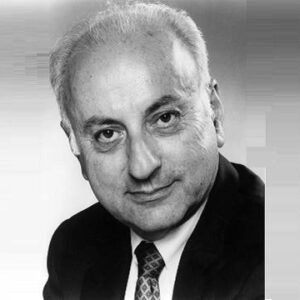Melvin Schwartz was an American physicist who, with Leon M. Lederman and Jack Steinberger, was a key figure in the creation of the neutrino beam method, for which they were awarded the Nobel Prize in Physics in 1988. The men’s groundbreaking experiments revealed the existence of two types of neutrinos for the first time. Schwartz, who was born in New York City during the Great Depression, had a rough upbringing as his parents tried to keep the family afloat financially. Despite the difficulties, his parents instilled in their young son the value of contributing to the advancement of humanity. He studied physics in the Bronx High School of Science, where he discovered his passion for the subject. After earning his PhD, he went on to Columbia University to study physics and began a career in academia. After a few years at Columbia, he became a professor of physics at Stanford University. He met his future collaborators, Jack Steinberger and Leon M. Lederman, at Columbia, and worked with them on the experiments that would earn them the Nobel Prize in Physics. After years of a successful academic career he pushed into uncharted territory and started a company, Digital Pathways.
Childhood and Adolescence
Melvin Schwartz was born in New York City on November 2, 1932, at the height of the Great Depression. His parents struggled to make ends meet, and he had a tough upbringing. The family, though, remained hopeful, and the young kid was taught by his parents to always strive to give back to humanity.
He was a bright young man who excelled in his studies at New York’s Bronx High School of Science. He discovered his passion for physics when he was 12 years old.
After graduating from high school, he went to Columbia University’s Physics Department, where he was taught by Nobel Laureate I. I. Rabi and was regarded one of the greatest places to study physics at the time. It was here that he met Jack Steinberger, who later became his instructor and mentor. Schwartz graduated from Columbia University with a bachelor’s degree in 1953 and a PhD in 1958.
Career of Melvin Schwartz
In 1958, he returned to his old university as an assistant professor after earning his doctorate. In 1960, he was promoted to associate professor, and three years later, he was elevated to full professor.
He spent a significant portion of his illustrious academic career at Columbia. He worked with his colleagues Jack Steinberger and Leon Lederman to conduct ground-breaking particle physics experiments. Tsung-Dao Lee, a Columbia colleague who had just received the Nobel Prize at the age of 30, also had a big influence on him.
Physicists struggled to investigate neutrinos in the 1950s because, despite their abundance, they rarely interact with other matter. If a beam of neutrinos could be created in a laboratory, Schwartz reasoned, neutrinos would be easier to investigate.
In the 1960s, he conducted tests at Brookhaven National Laboratory on Long Island alongside Steinberger and Lederman to further study this idea. The scientists utilized a particle accelerator to create a stream of high-energy protons, which they then fired at a beryllium target. These collisions produced a stream of various particles, always in pairs, such as a muon and a neutrino. The scientists were able to investigate the collisions between neutrinos in the beam and aluminum atoms in a 10-ton detector as a result of this. The muon neutrino was found as a result of these experiments.
Schwartz moved to Stanford University in 1966 after 17 years at Columbia. The transfer was primarily motivated by the fact that a new accelerator, SLAC, was about to be finished, and his knowledge and experience would be useful for research there.
He worked on a study at Stanford that produced and detected relativistic hydrogen-like atoms made up of a pion and a muon, and he was also a part of another experiment that produced and detected charge imbalance in the decay of the long-lived neutral kaon.
He developed and served as the Chief Executive Officer of Digital Pathways in the 1970s. The firm specialized on safe data communication management. In 1983, he left Stanford to work full-time for his company.
In 1991, he joined Brookhaven National Laboratory as Associate Director of High Energy and Nuclear Physics. He returned to Columbia as a Professor of Physics about the same time, and was named I. I. Rabi Professor of Physics in 1994. In the year 2000, he announced his retirement.
Major Projects of Melvin Schwartz
Melvin Schwartz found that there are multiple types of neutrinos while working with his Columbia colleagues in 1962. They discovered interactions of the muon neutrino throughout their research, which was a groundbreaking discovery at the time.
Achievements & Awards
In 1965, Melvin Schwartz was awarded a Guggenheim Fellowship.
He was inducted into the National Academy of Sciences in 1975.
Melvin Schwartz was awarded the Nobel Prize in Physics in 1988, along with Leon M. Lederman and Jack Steinberger, “for the neutrino beam method and the evidence of the doublet structure of the leptons through the discovery of the muon neutrino.”
Personal History and Legacy
Melvin Schwartz was blissfully married to Marilyn, who was always by his side and a pillar of strength. They had three children together.
After battling Parkinson’s disease and hepatitis C, he died on August 28, 2006.
Estimated net worth
Check Melvin Schwartz’s net worth in 2020. Melvin Schwartz automobiles, Melvin Schwartz income, salary, and lifestyle are all covered. Melvin Schwartz’s estimated net worth is $ USD 6 million, according to online sources (Wikipedia, Google Search, Yahoo Search). His primary source of income is as a university teacher and physicist. We don’t have enough information about Melvin Schwartz’s cars or lifestyle. These details will be updated as soon as possible.


